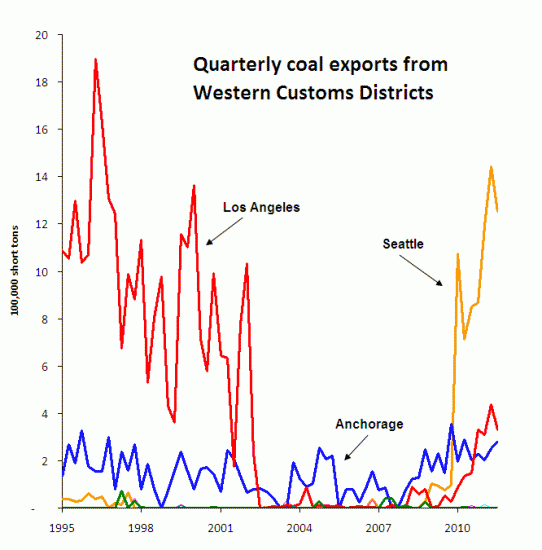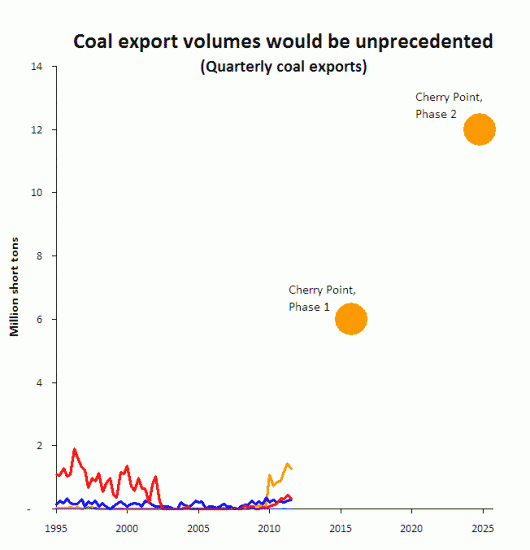Here’s a look at the latest coal report from the US EIA, taking us up through the third quarter of 2011. In this chart, you see the past 15 years of quarterly data.
I’m showing Customs Districts here, not ports. The Port of Seattle does not move coal. But some coal does get exported out of the Seattle Customs District region by way of the rail crossing at Blaine, Washington. It is, by all accounts, Powder River Basin coal heading to BC’s Westshore Terminal for onward shipment to Asia.
Somewhat surprisingly, the third quarter of 2011 saw a decline in coal export volumes in both the Seattle and Los Angeles Customs Districts, as well as in the West overall. The Seattle District moved 1.25 million tons of coal in the third quarter, down 13 percent from the second quarter. Los Angeles District exports were down 25 percent. Right now, it looks like the Seattle District will ship just a bit more than 5 million tons in 2011. (Final 2011 numbers are due out in March, and I’ll report them here.)
It may look as though the West has been experiencing a coal export boom in 2011, but the volumes here are really nothing compared to what coal companies are planning. For context, here’s the same data plotted against the plans for the Cherry Point project alone:
Needless to say, if even the first phase of Cherry Point gets built, the region will experience coal shipments at a level that bears no comparison to current coal traffic.
There’s one additional surprise in the data. Coal exports out of the Great Falls Customs District continue to flat line at near-zero figures. Despite persistent rumors that Powder River Basin coal shippers will use the Sweetgrass, Montana rail crossing to move their product north to Ridley Terminals at Prince Rupert, BC, there’s increasingly good evidence that’s not actually happening. In fact, in all of 2010 and the first three quarters of 2011 combined, scarcely 14,000 tons of coal was exported via Sweetgrass.
It’s possible that some Ridley-bound coal is moving instead via the Blaine crossing in the Seattle District, though that’s a tortuous and congested route. More likely, Ridley is so far away that it’s too expensive for coal companies to use, which means that at least at current prices it is not a viable alternative to port facilities in Oregon, Washington, or southern BC.
Thanks to Pam MacRae for research assistance.
All of my reporting on quarterly coal export volumes can be found in the series “Coal Export Trend Reports.” All data come from the US EIA’s latest quarterly coal report, covering the entire Western Customs Region. In addition to the districts shown on the chart here, the Western Region includes the Portland, Great Falls, Nogales, San Diego, and San Francisco Districts. These districts have been reporting virtually no coal exports.




Comments are closed.